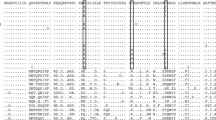Abstract
Somatic antigens of Bradyrhizobium japonicum, Rhizobium sp. (Cicer arietinum) and Rhizobium sp. (Leucaena leucocephala) were prepared as standard, single-species type from cultured cells. Equal numbers of the cells of these rhizobia were then combined to obtain a mixed-rhizobial-species antigen preparation. Rabbits were immunized either with the standard, single-species type or with the mixed-rhizobial-species antigen preparations. The antisera developed from the mixed antigen immunization contained antibodies for all three rhizobial species, detectable at agglutination titres of over 800. The mixed-rhizobial-species antisera were made species specific by cross-absorption. The cross-absorbed and the mixed-rhizobial-species antisera were generally similar in quality for strain identification by agglutination, fluorescent antibodies, immunoblot and ELISA. A 66% reduction in cost was estimated for the production of antisera by immunization with mixed-rhizobial-species antigen.
Similar content being viewed by others
References
BallE.M., HamptonR.O., DeBoerS.H. & SehaadN.W. 1990 Polyclonal antibodies. In Serological Methods for Detection and Identification of Viral and Bacterial Plant Pathogens, eds HamptonR., BallE.M. & DeBoerS.H. pp. 33–55. St. Paul, Minnesota: APS Press, The American Phytopathological Society.
BergerJ.A., MayS.N., BergerL.R. & BohloolB.B. 1979 Colorimetric enzyme-linked immunosorbent assay for the identification of strains in culture and in the nodules of lentils. Applied and Environmental Microbiology 37, 642–646.
DudmanW.F. & BrockwellJ. 1968 Ecological studies of root-nodule bacteria introduced into field environments. I. A survey of field performance of clover inoculants by gel immune diffusion serology. Australian Journal of Agricultural Research 19, 739–747.
HollandA.A. 1966 Serological characteristics of certain root-nodule bacteria of legumes. Antonie van Leewenhoek Journal of Microbiology and Serology 32, 410–418.
HumphreyB.A. & VincentJ.M. 1965 The effect of calcium nutrition on the production of diffusible antigens by Rhizobium trifolii. Journal of General Microbiology 41, 109–118.
KishinevskyB. & GurfelD. 1980 Evaluation of enzyme-linked immunosorbent assay (ELISA) for serological identification of different Rhizobium strains. Journal of Applied Bacteriology 49, 517–526.
KishinevskyB. & JonesD.G. 1987 Enzyme-Linked Immunosorbent Assay (ELISA) for the detection and identification of Rhizobium strains. In Symbiotic Nitrogen Fixation Technology, ed ElkanG.H. pp. 157–184. New York: Marcel Dekker.
OlsenP.E. & RiceW.A. 1984 Minimal antigenic characterization of eight Rhizobium meliloti strains by indirect enzyme-linked immunosorbent assay (ELISA). Canadian Journal of Microbiology, 30, 1093–1099.
OlsenP.E. & RiceW.A. 1989 Rhizobium strain identification and quantification in commercial inoculants by immunoblot analysis. Canadian Journal of Microbiology 55, 520–522.
SchmidtE.L., BankoleR.O. & BohloolB.B. 1968 Fluorescent-antibody approach to study of rhizobia in soil. Journal of Bacteriology 95, 1987–1992.
SomasegaranP. & HobenH.J. 1994 Handbook for Rhizobia: Methods in Legume-Rhizobium Technology. New York: Springer-Verlag.
SomasegaranP., WoolfendenR., & HallidayJ. 1983 Suitability of oven-dried root-nodules for Rhizobium strain identification by immunofluorescence and agglutination. Journal of Applied Bacteriology 55, 253–261.
TrinickM.J. 1969 Identification of legume nodule bacteria by the fluorescent antibody reaction. Journal of Applied Bacteriology 32, 181–186.
United States Department of Health and Human Services 1985 Guide for the Care and Use of Laboratory Animals, Bethesda: National Institutes of Health.
VincentJ.M. 1970 A Manual for the Practical Study of Root-Nodule Bacteria. Oxford: Blackwell Scientific.
WrightS.F., FosterJ.G. & BennetO.L. 1986 Production and use of monoclonal antibodies for identification of Rhizobium trifolii. Applied and Environmental Microbiology 52, 119–123.
ZipfelH. 1912 Beiträge zur Morphologie und Biologie der Knöllchenbakterien der Leguminosen. Zentralblatt für Bakteriologie, Parasitenkunde, Infectionskrankheiten and Hygiene, Abteilung II 32, 97–137.
Additional information
H.J. Hoben and P. Somasegaran are with the NifTAL Center and MIRCEN, University of Hawaii, 1000 Holomua Road, Paia, Maui, HI 96779-9744, USA: N. Boonkerd is with the School of Agricultural Technology, Suranaree University of Technology, University Avenue, Nakorn Racharsima, Thailand. Y.D. Gaur is with the Division of Microbiology, Indian Agricultural Research Institute, New Delhi-110012, India.
Rights and permissions
About this article
Cite this article
Hoben, H.J., Somasegaran, P., Boonkerd, N. et al. Polyclonal antisera production by immunization with mixed cell antigens of different rhizobial species. World J Microbiol Biotechnol 10, 538–542 (1994). https://doi.org/10.1007/BF00367662
Revised:
Accepted:
Published:
Issue Date:
DOI: https://doi.org/10.1007/BF00367662




